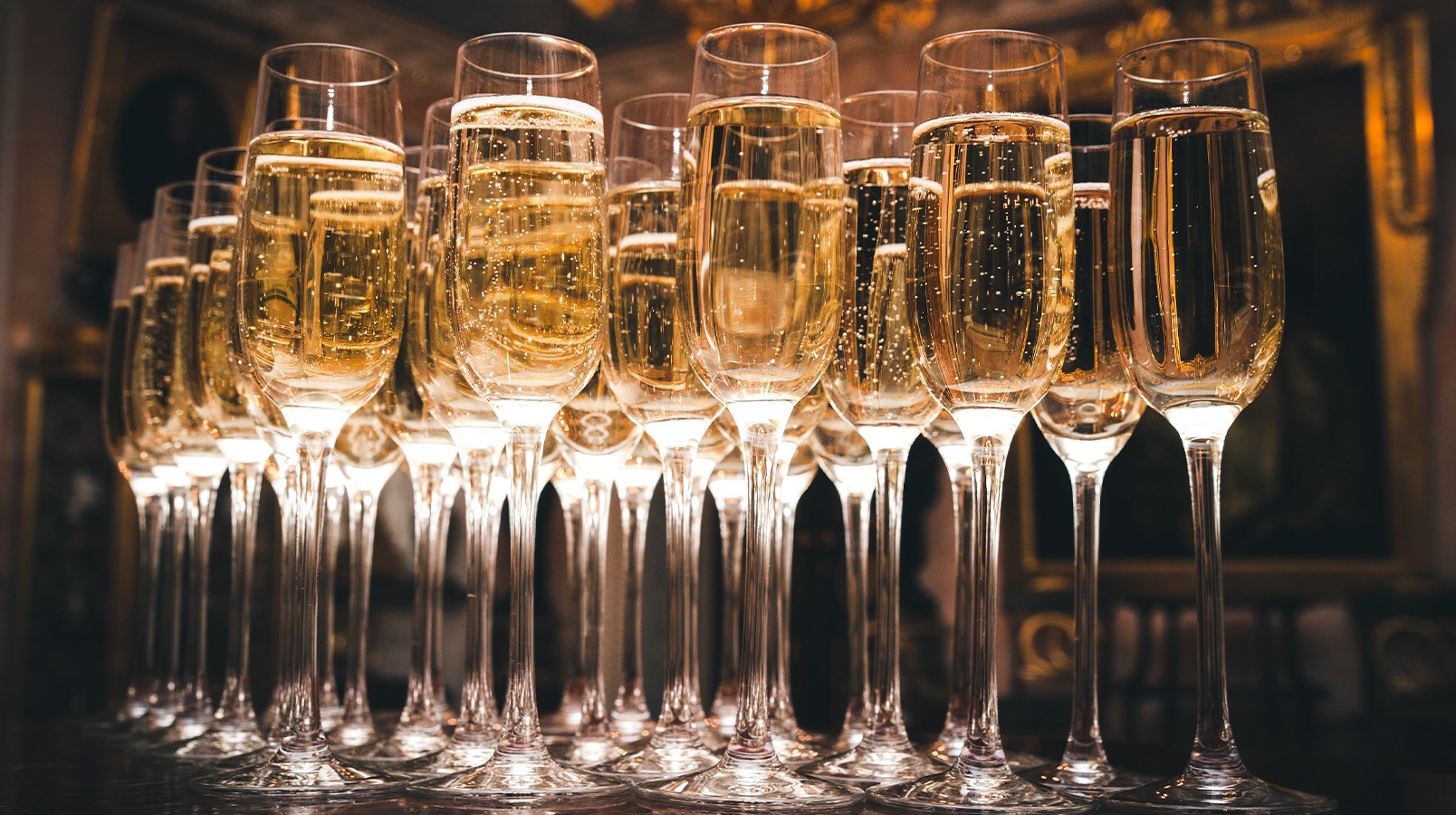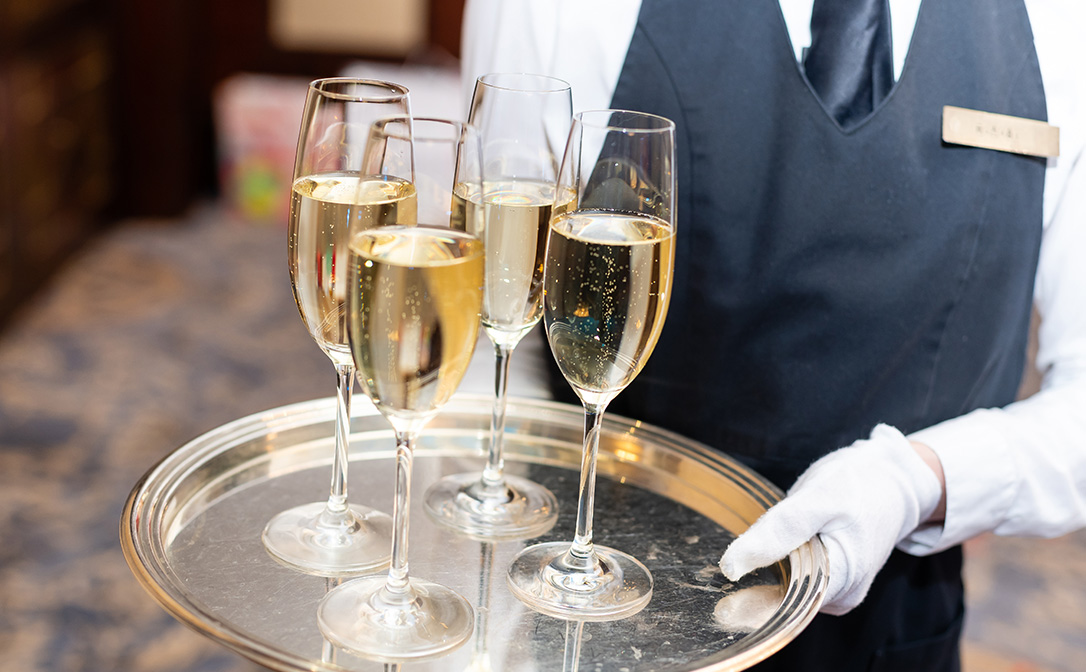If, like me, your vinous tastes don’t match your disposable income, you’ve no doubt searched for some magical glass that can transform the humble discount sparkler into something akin to your favourite prestige cuvée.
And you’d be in luck. Well, sort of. There've been many articles on glassware for sparkling wine published in recent times, often with a sommelier, consultant or glassware manufacturer claiming they've designed the optimum champagne glass.
But with so many sparkling champagne glass shapes claiming to be "the best", which should you choose? And how come each expert recommends a different glass shape? Firstly, there are variations in the way the glasses have been tested, ranging from controlled experiments through ad-hoc "kitchen table" tastings to focus groups of wine critics. Which method is the most valid? Well, that’s what my research sought to investigate.
Our sensory perception could be influenced by glassware in two main ways:
- The glass shape physically affects what we sense – the aromas and flavours reaching the receptors in our nose or mouth are influenced by the glass.
- Personal preferences for or against different glass shapes influence how the brain processes the information from our receptors – our receptors might receive exactly the same information on aroma and flavour but a preference for or a prejudice against a glass shape means the brain changes our conscious perception of them.
With little published research on how these two ways individually influence the performance of sparkling glassware, plus a passion for champagne and a degree in psychology, I undertook a systematic study into these effects, which will be of interest to producers, sommeliers and customers alike.
Champagne Day is celebrated on Friday 28 October 2022, and what better way to take part than with a glass of fizz as we learn all about the world of Champagne. Sign up to Wine Explorer: Introducing Champagne for free here.
Evidence for a physical effect
Professor Gerard Liger-Belair at the University of Reims has extensively researched bubble flow patterns in champagne. Bubbles not only create a pleasant mousse in sparkling wines but also transmit aroma and flavour compounds to the surface of the wine and, on bursting, release these compounds into the air. The greater the depth of liquid in the glass, the more the bubbles accelerate as they rise and the further they will spread across the liquid surface, increasing the surface area over which aroma is being released.
In a tall flute glass, there is a large depth of liquid but the narrow shape constrains the surface over which bubbles can spread. In a flat, wide coupe, the lack of depth means the slow-moving bubbles congregate near the centre with little bursting closer to the rim. Therefore, a glass's depth and liquid surface area are very influential in aroma release.
Another factor is the head space in the glass. The straight-sided, open-topped shapes of the flute and coupe mean that aromas easily escape into the atmosphere whereas the in-curving tops of many wine glasses and tulip-shaped flutes are better at slightly enclosing the aromas released and funnelling them towards the nose.
So, from looking at bubble patterns, wine glasses and tulip flutes should physically enhance the aromas of champagne... but does this happen in practice?
Evidence for a psychological effect
Whilst there have been many studies conducted on the sensory perception of food and drink from a psychological standpoint, relatively few consider the influence of glassware on wine, and none on sparkling wine. Studies on still wine have tended to confirm that glass shape influences a wine's smell or taste but usually only when participants can see the glasses, suggesting a psychological influence.
Many people still view the flute as the iconic champagne glass. With such a strong association between the flute and champagne, could this mean that the wine inside the flute is enhanced in people's perception? Likewise, although the white wine glass may be better physically for enjoying champagne, would its shape be seen as untraditional or unsuitable and any benefits be masked?
My research
I sought to examine the physical and psychological influences of the champagne glass on the aromas perceived and if these influenced individually or in combination.
The experiment was conducted on two groups of participants. They experienced exactly the same champagnes in the same range of glasses, but with one group seeing and touching the glasses whilst the other was blindfolded and assisted by experimental helpers, thus removing the ability to see, touch and form any prejudicial judgements on any glasses.
Four Riedel™ glasses of different shapes but comparable quality were employed and two similar champagnes, both being Pinot Noir-dominant, Premier Cru, NV grower champagnes. Every participant sampled eight times - each champagne in each glass. The 89 participants were WSET Level 2 or 3 students, representing "engaged wine consumers".
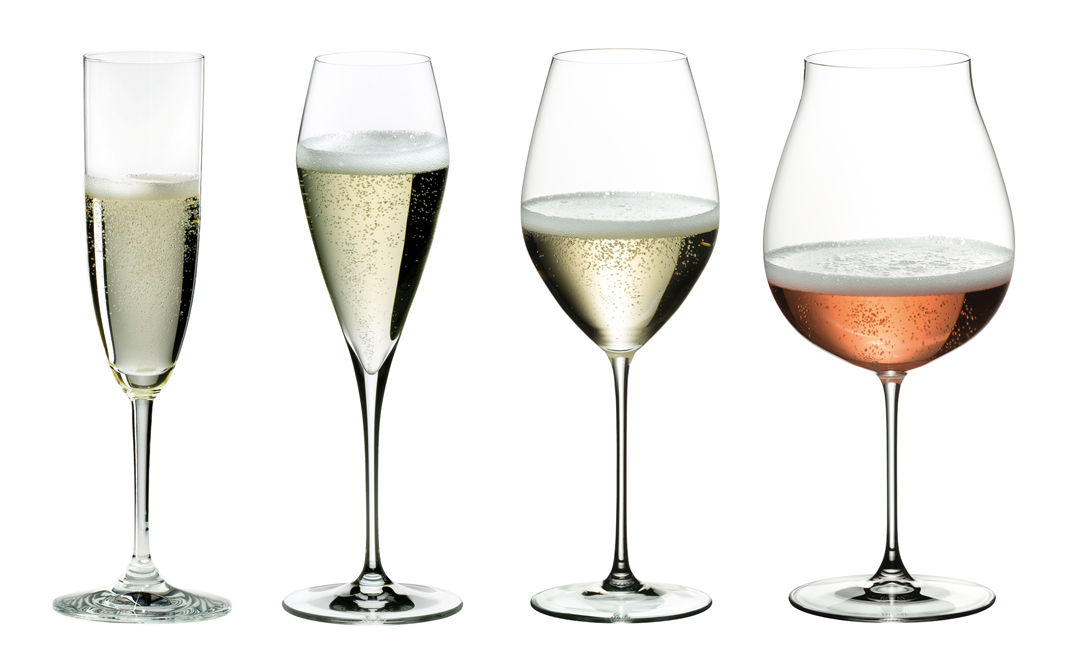
Glasses left to right: flute, tulip flute, white wine and bowl. Images courtesy of Riedel™
Participants recorded the aroma intensity and aroma appeal (how much they liked the aromas) of each wine on a scale of 1-9. Unfortunately, taste could not be reliably tested within this format as blindfolded participants might gain some indication of glass shape from contact with their lips. However, in glassware literature, the aroma is commonly cited as the main reason for choosing one glass over another.
Results
It's only fair to comment that this is a single study in an area where research is rarely published. More work would be needed to confirm the reliability and further investigate unanswered questions and topics in this interesting and under-explored area of research. Unfortunately, the cost of buying further champagne means that I couldn't take it on without a substantial grant!
Focusing first on the results of the blindfolded group (where glassware could only exert a physical influence on perception), the aroma intensity from the flute was rated significantly lower than the other three. This supports the evidence from bubble flow patterns that glasses with a moderate depth, greater surface area and a constricting headspace enhance the intensity of aromas.
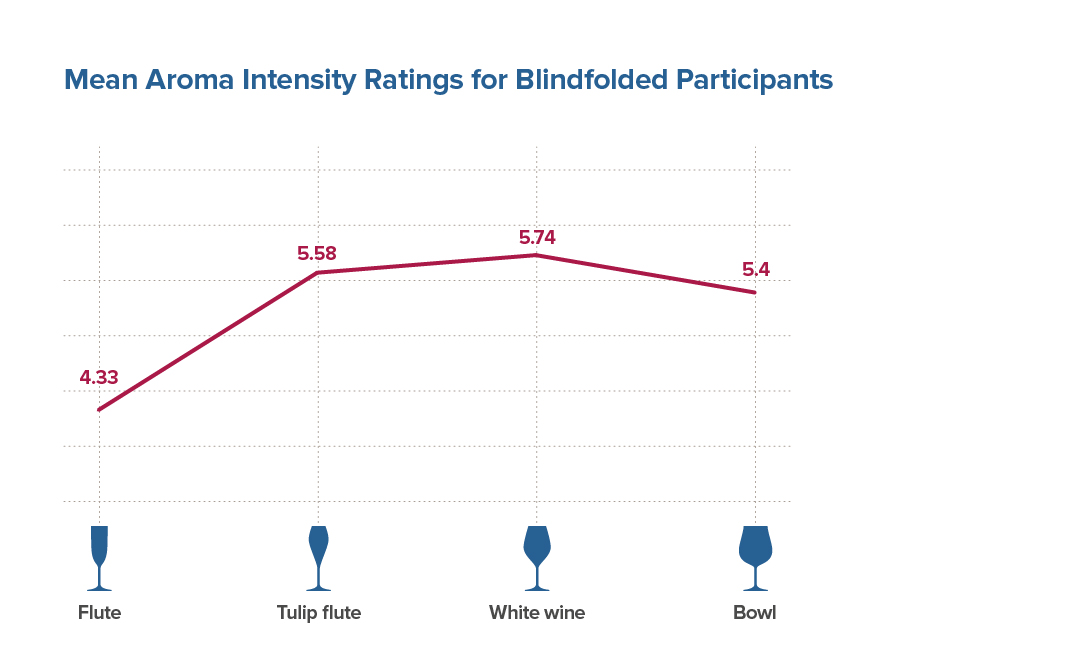
The flute's aroma appeal was rated as significantly less than the white wine-shaped glass but, whilst also less appealing than the other two shapes, wasn't significantly so. This wasn’t altogether unexpected; it's clear how the number of bubbles bursting would affect intensity but the impact on appeal is less obvious unless perhaps a greater complexity of aromas are captured within the headspace.
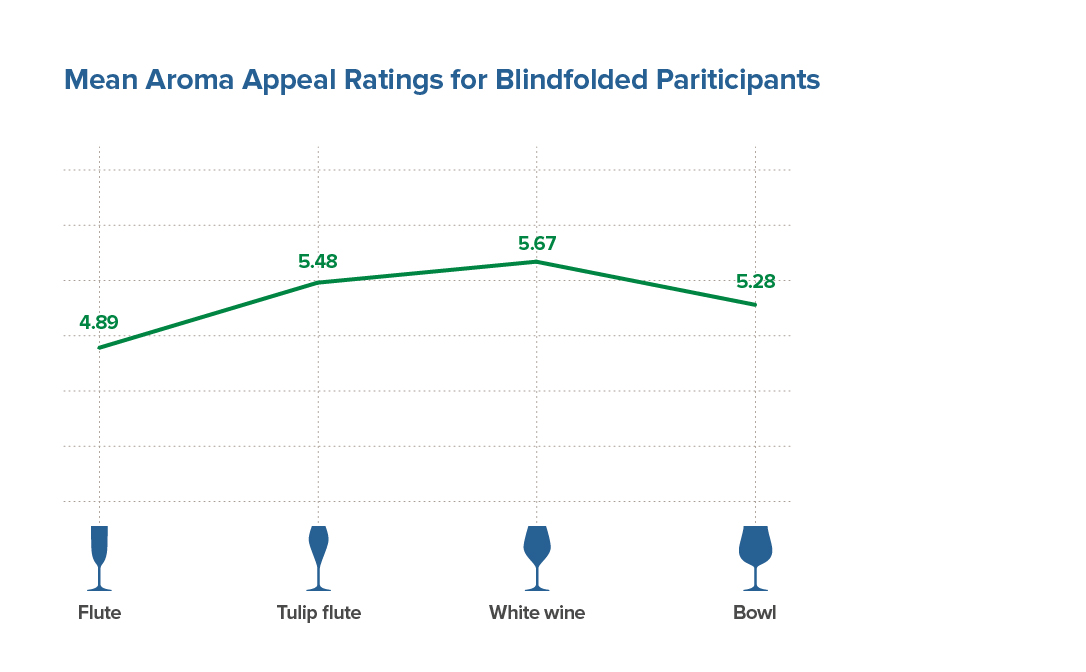
To see whether a psychological influence could be detected, I looked for a statistically significant difference between the ratings from the blindfolded group and from the sighted group.
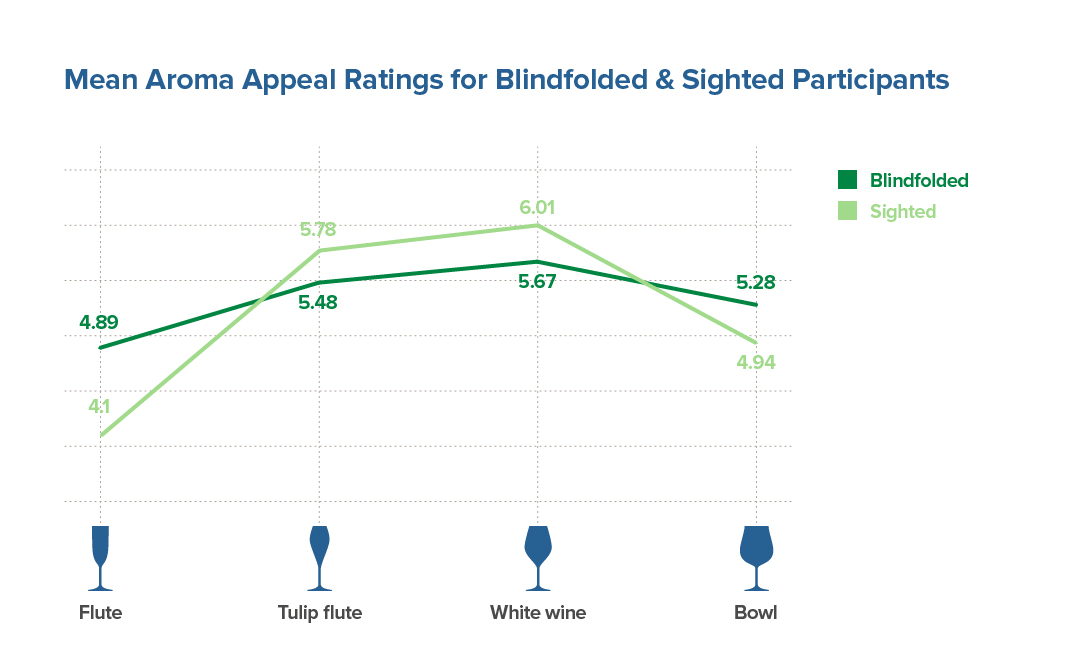
There was indeed a significant difference between the aroma appeal ratings given by the two groups, with the flute and bowl shapes rated lower when sighted and the tulip flute and white wine shapes rated more highly. Despite not being statistically significant, broadly the same pattern was seen for aroma intensity, the two results implying that some sort of psychological effect may be at play as well.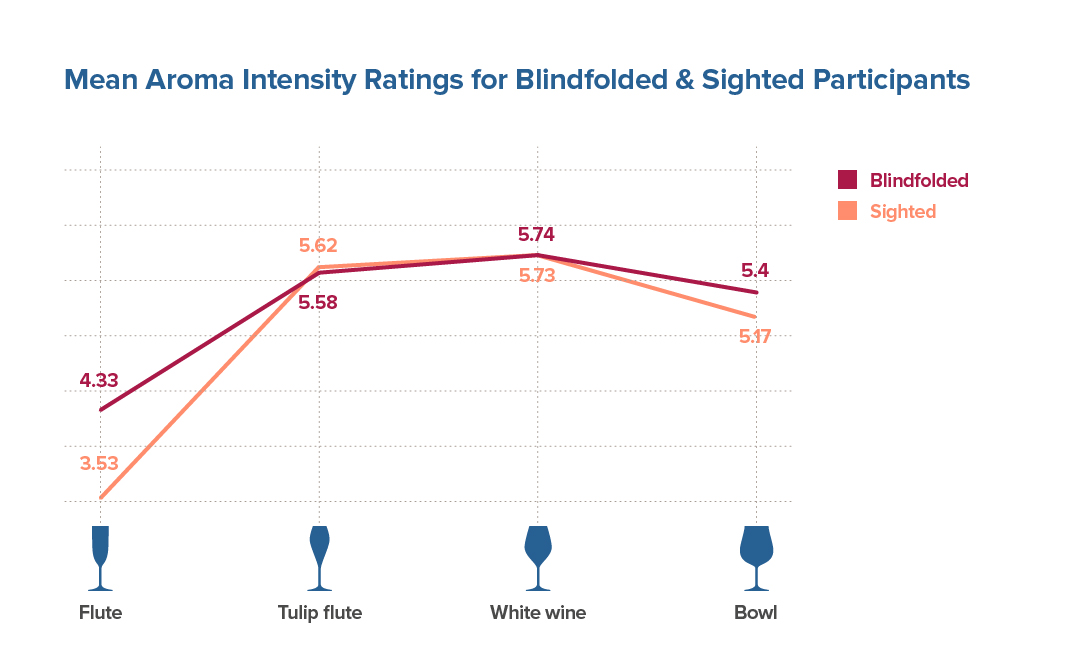
What is perhaps surprising is that the traditional flute performed even worse when participants could see it. This is possibly because these ‘engaged’ participants had already seen articles promoting rounder glasses for champagne; it would be illuminating to repeat the experiment with "average consumers".
As a complementary study, I conducted a questionnaire on a group of matched participants, to investigate their opinions of the glasses and whether any of these feelings seemed to link to the psychological effect. Here, the perceived potential of the glass to enhance aromas and flavours was the closest fit and hence it seems that, if engaged wine consumers think a glass will enhance aromas, the processing in their brains may make this a reality!
Implications
Glassware was shown to physically influence aroma intensity, with slightly different but consistent scorings for the two champagnes used. It is therefore possible that there could be an optimal glass for each different cuvée. Champagne houses could thereby maximise their consumers' experiences by creating glasses that enhance their champagnes' characteristics.
However, there was also a psychological influence on aroma appeal. If customers consider that being offered appropriate glassware is important for their enjoyment of champagne, could subtle priming make a big difference? If a sommelier mentions to his or her guests that the glass has been specifically selected as it optimises the aromas and flavours of that champagne, not only may the guests appreciate the bespoke experience, they might actually better enjoy the champagne itself.
Conversely, whilst, say, the bowl glass shape might actually be well suited to more flavoursome and evolved styles of champagne, if consumers think the shape is wrong, then they may enjoy the wine less. Care, therefore, needs to be taken to match the glassware to the customer and event in question.
So which is the best glass for champagne? Well, all pundits are probably telling the truth as they see it, in that they could genuinely be getting a better experience from the glass they're advocating because their method of testing has led them to believe that... and as long as you believe them, their glass could enhance your experience too.
Are there magical glasses out there? Probably not, but our brains may beg to differ.
Find out if the glassware matters for spirits.
This article was prepared by Vicky MacKenzie MW, WSET Product Development Manager - Wine Qualifications. It is an abstract from her Research Paper (the third stage of the Master of Wine Examination), ‘Does glassware have an impact on the sensory perception of Champagne? An investigation into the relative influences of physico-chemical and psychological processes in the sensory perception of two Pinot Noir-dominant Brut NV champagnes’. You can request to read the full Research Paper through the Institute of Masters of Wine by completing this form.
Published originally on 02/06/2017.
Related content:
- Traditional vs alternative food and drinks pairings for Christmas
- Making ‘traditional method’ sparkling wines
- An introduction to sparkling wine


